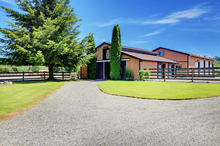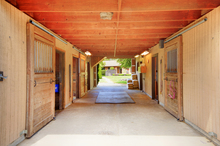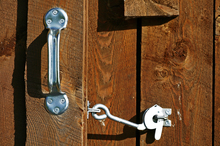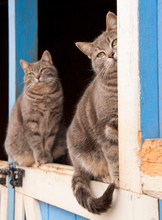The horse barn

A high-end barn
Beautiful architecture and landscaping; a high-end barn goes beyond the basic equine needs.
The physical plan of a properly designed horse barn will promote the health and safety of horses from foal to senior, while allowing each horse to perform at its maximum level. A "good" barn will pay off in the long run with fewer veterinarian visits, lower maintenance costs, and fewer repair bills.
The thought, time, effort, and resources you put into creating the best possible barn for your horse will not only save you money, but will provide a pleasant day-to-day setting for you and your horse as you work and play together.
Many experts on barn design have written books, and provided internet resources to help horse owners design or improve their property whether beginning with new construction or simply reworking a facility already in use. This guide will bring to your attention the major considerations involved in making your plans a reality.
What will a well-designed horse barn do?
A well-thought out barn will accomplish the following:
- Provide functionality - in other words, make life easier for you and your horse by providing useable spaces that relate conveniently to each other and save steps and time on any given day.
- Provide good ventilation and maximum natural interior light.
- Provide protection for horses, humans, tack, feed, and other related necessities both from the elements and from damage or misuse.
- Provide protection against pests, rodents, fumes, odors, dust, dirt and debris.
- Provide safety for horses and handlers through use of properly selected materials and allowance for safe passage of horses and handlers with adequate doors, gates, and alleyways.
- Make waste disposal easy and efficient
A note on animal welfare
The barn is an integral part of housing and caring for your horse's well-being. Unfortunately, barn housing is not "natural" from the horse's perspective. Horses are social animals, barns often isolate horses, limiting touch and mutual grooming opportunities. Also, barn housing limits exercise and can lead to boredom and the potential for the development of behaviors that are abnormal.
In addition to your barn, you must plan for pasture turn-out, and for important social time where horses can interact one with another for the best possible horse health and well-being.
Basic barn functionality
Important considerations for having a barn that functions in the best interests of you and your horse include the following:
Size and layout
Size and layout depend on how many horses you have and how the barn will be used. If you live in a cold climate, your barn will be constructed and laid out differently than it would be in a warmer climate. If you are an avid competitive rider, your barn will need different accommodations for training needs than a barn for the casual keeper and rider of horses. Among your considerations will be:
- Stall size
- Passageways and open work areas
- Door and window size and location
- Tack room layout and blanket/equipment storage
- Wash rack and grooming area
- Feed storage and access
- Water distribution and access
Ventilation and interior lighting

Modern horse barn breeze-way
Wide aisles, ample lighting, good ventilation and floor mats are basic features of the modern horse barn.
Proper ventilation and lighting can make or break the health of a barn. Too little ventilation and poor lighting can affect the physical and mental health, not only of horses, but of the handlers, as well.
Dust and mold lurk in hay, grain and bedding; ammonia fumes, particles of fecal matter, fungal material along with viruses and bacteria, methane and noxious gases combine with moisture in the air and lead to allergies, respiratory distress and other problems.
Adequate ventilation will take into consideration the air exchange needed by your horse. The objective of good ventilation is to take advantage of wind, air currents, and thermal buoyancy.
Natural ventilation uses openings located along wide walls and the roof ridge and takes into consideration the topography where the barn is situated in relationship to its surroundings.
Instead of trying to follow residential housing patterns and practices, a well designed barn will get fresh air to the horse, while eliminating stale air before it accumulates especially in areas where horses are kept in stalls much of the time.
Instead of closing the barn up tightly by closing all windows, doors, and fresh-air inlets in cold weather, maximum circulation should be allowed to occur. Veterinarians tell us that horses are most comfortable in temperatures ranging from 45 to 75 degrees, and certainly, circulating fresh air will help in controlling moisture, odor, ammonia and pathogen build-up during all seasons of the year.
Properly installed fans and duct systems, along with an open-door policy whenever possible will allow maximum ventilation efficiency especially in stall areas.
Your county extension office and universities with animal programs are good sources of information and plans related to adequate ventilation for barns and stables in your area.

Horse barn with natural lighting and high ceilings
Pre-fab and steel horse barns can be designed to provide bright and airly living spaces. These barns are also less likely to catch fire than their wooden counterparts.
Along with adequate ventilation, good lighting with an emphasis on making maximum use of natural sunlight should be a consideration in any barn and stable design. Skylights and sensible placement of windows should allow maximum light into the barn during daylight hours.
Not only is sunlight easier to live and work under than artificial light, but it also is a potent killer of a wide range of airborne viruses, bacteria, parasite eggs and larvae.
Editor's note
Over the last few years, a movement away from the use of glass or Plexiglas windows that can break or shatter thereby creating a hazard has occurred. Use of skylights and light strips in the roof, and different lighting systems in barns have become popular.
Skylights should have plastic or UV light translucent safety glass to allow the useful UV rays to penetrate the barn and stable atmosphere. Windows should be constructed of safe materials and should open and close safely and securely while taking advantage of as much natural light as possible.
Protecting the horse barn from the elements, damage and misuse
The design of your barn and stable should not only protect you and your animals from the elements of wind, rain, snow, heat and cold, but should also be geared to prevent damage by horses and humans, and should also help prevent misuse of supplies, tack, feed, and other necessities kept in the area.
While the physical structure of the barn should provide protection from the elements, it is important to prevent damage and misuse of the interior trappings and supplies of the various areas in the barn and stables.
Horses can be wily creatures and can chew or kick through walls and doors, electrical wiring, plumbing, insulation, and other components of the typical barn or stable if attention has not been paid to these possibilities. In designing and constructing your barn and stable, it pays to think like a horse, especially if your horse might engage in stereotypies such as stall walking, cribbing, or kicking.

Barn door security
Horses become masters at unlocking standard gate and door latches. Look for latches designed specifically to foil your horses attempts.
Securely covering electrical wiring, plumbing, and insulation should prevent your horse from damaging important components of the barn.
Latches should be horse-proof if you don't want your horse to invade the feed storage area with disastrous consequences.
Feed and tack should have properly secured areas with consideration for preventing invasions by rodents, insects, mold, and other destructive elements.
Any medications, dewormers, insecticides and other potentially lethal products necessary to your horse's health should be properly stored according to the manufacturer's suggestions, and only those trained in their use should have access to them.
Wash racks and horse waterers should be correctly installed to prevent drainage and moisture problems. A little research will help you decide which horse waterers will work best for you and where they should be placed to encourage your horse to drink an adequate amount of water.
Provisions should be made for keeping floors and other areas dry, and for removing any build-up of water quickly and efficiently to prevent damage to the structure, the horses or handlers that might slip and fall.
Protection against pests, rodents, fumes, odors, dust, dirt and debris
A well designed barn and stable area will be as rodent and pest proof as possible and will be designed to prevent the accumulation of fumes, odors, dust, dirt and debris.
Wherever you find horses, you will find flies, intestinal parasites, gnats, and other pests that make life difficult for both horse and handler. In addition rodents are attracted to feed and grain and can become a problem if preventative measures are not taken.
Hanging fly strips or traps, using biological controls such as predatory wasps that feed on fly larvae, applying fly sprays or wipes to your horse or dressing your horse in a fly mask, sheet or leg wraps can be effective measures against insects and other pests.

The barn cat
Having a barn cat or cats to provide rodent control is a very common practice in most barns.
We are all familiar with the lore of the barn cat. Having a cat or two on the premises can help cut down on the rodent population. Keeping feed and grain covered and inaccessible to rodents and other animals such as raccoons will save not only time and money, but also prevent virus and bacteria carrying rodents and wild animals from making a living at your expense.
Fumes from the ammonia in urine, odors from manure and soiled bedding and other noxious problems can be done away with by adequate ventilation and by regular changes of bedding, mucking of stalls, and use of effective cleaning products on walls, floors, and in all areas of the barn and stables.
If at all possible, hay should be stored in a separate area, not in the loft of the barn to maximize not only safety from fire, but also to cut down on dust, mold, and other pests commonly found in hay.
Regular sweeping up of dirt and debris and cleaning of the premises combined with an adequate number of trash receptacles conveniently placed can minimize work and maximize the cleanliness of all barn areas.
Safety for horses and handlers
Safety of horses and handlers is a major concern in the design and building of any barn or stable area. Allowance for safe passage at all times with adequate doors, passageways, and easily-opened gates works both on a daily basis, but also in cases of emergencies such as fires or floods.
Good design and construction will allow workers to feed and water horses without walking behind them, and will allow for storage of equipment and supplies in areas that will not create bottle-necks or obstacles.
Use of durable, fireproof, materials in all phases of construction is important to prevent possibly fatal mishaps or injuries. Doors and walls should be constructed of horse-proof materials that won't break, burn or shatter wherever possible.
Ease of maintenance, durability, esthetic appearance, and cost- effectiveness are important considerations in your decision-making process. Flexibility in construction that allows alternate uses and changes in the future as your needs change are also important considerations.

A horse and owner in a wash rack
Safety for both horse and owner are a major concern for the modern horse facility designer.
The wash rack is of special importance because it can become one of the most dangerous places in the barn or stable area. Surfaces that may become slippery when wet need to be avoided, and provisions need to be made to prevent potential water/electrical hazards.
Positioning of water hoses, grooming supplies, cleaning equipment and the ability for tying or cross tying the horse are necessary considerations for both horse and handler safety.
Easy and efficient waste disposal
Whether you have one horse or fifty, accumulated manure, used bedding, and ammonia-soaked waste can become a problem in a hurry. In designing your barn and stable areas, it is wise to make easy and efficient waste disposal one of your highest priorities.
Constructing stalls, feeding areas, and other areas of the barn to allow for the easy removal of waste materials whether by shovel full, wheelbarrow, or truck, is important both from a health and an efficiency standpoint.
Floors, doors, shoveling or sweeping equipment, placement of waste receptacles, and provisions for getting the waste to the compost pile* or disposal place should factor into the initial planning of your barn and stable area.
Proper removal and disposal of waste has very positive ramifications when it comes to the health and well-being of your horse.
Consider this
Creating a healthy barn can be a complex issue. The best way to go about it is to take one step at a time while considering your needs for durability, ease of maintenance, cost, esthetic appearance and the intangible values of your own pride and satisfaction in your accomplishment.
Note: This Healthy Barn article is a reprint of article published earlier on EquiMed
